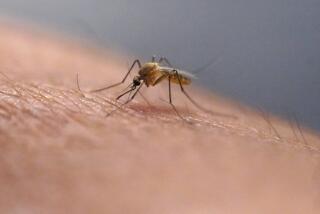Going Buggy? You Just Might Be a Mosquito Magnet
- Share via
Summer’s here--a time of sizzling barbecues and seasonal advisories warning us to wear sunscreen, drink enough fluids, stay out of the sun, avoid gobbling down the more than 3,000 calories contained in a typical barbecue meal and avoid catching bubonic plague from wild rodents.
Medical journals have their summer themes too. Take last week’s New England Journal of Medicine. On Page 35, there’s a botanical feature titled “The Many Faces of Poison Ivy,” with the pretty, three-leaved shrub depicted in full color. Then, on Page 13, there’s a special on mosquito repellents. Which ones work? Which ones don’t? And how well?
Dr. Mark Fradin, a Chapel Hill, N.C.-based dermatologist, decided to tackle the issue because he was seasonally barraged with such questions and couldn’t provide easy answers. (There aren’t standardized tests for measuring repellents, he says. Each company does it its own way.)
Driven by the need to know, Fradin went off to the drugstore and bought up every repellent he could lay his hands on. He also called Avon to get a sample of its bug-repellent products. Then he solicited the help of mosquito expert John F. Day of the University of Florida’s Medical Entomology Laboratory in Vero Beach, a place where researchers house mosquitoes in little cages and do all kinds of experiments on them.
With the help of 15 volunteers, the “arm in cage” tests began.
First, a volunteer’s arm was slathered with one of 16 products. Then the arm was slipped into a cage where 10 choice, female, disease-free Aedes egyptii mosquitoes were ready and waiting. The owner of the arm patiently waited for the first mosquito to land a bite. When it did, the time between entry of arm and first bite was recorded.
To ensure fairness and accuracy, the test was done three times per product, and each volunteer tried every single product in turn. (Some arms, after all, are yummier than other arms.) Mosquitoes taking the arm test were equally aged and equally hungry.
The results: Products containing N,N-diethyl-3-methylbenzamide (commonly known as DEET) worked a lot better than any other products on the market. Depending on the particular concentration of DEET, they protected arms from bites for 90 minutes to several hours.
Plant-based products mostly fared far less well. One of them, based on soybean oil, could protect arms for about 90 minutes, as could another based on oil of eucalyptus. But others, with chemicals from citronella, cedar and eucalyptus, protected arms for average times of three to 20 minutes. Wristbands treated with DEET and plant-based chemicals performed shabbily too.
Worries about DEET’s toxicity surface every summer, but Fradin says actual reports of toxicities are rare--less than 50 published cases out of an estimated 8 billion applications over the last 45 years. “In many of those cases the product was applied in ways that completely defy common sense,” he says, such as a man who, every day for three weeks, slathered himself head to toe with the chemical then sat in his sauna for three hours.
“That is not how most people apply an insect repellent,” Fradin says. Here are some more mosquito facts, should your appetite not yet be sated:
* The mosquito’s biting mouthpart--the proboscis--is double-barreled, allowing it to slobber saliva into the bite wound down one barrel while sucking up blood with the other.
* Mosquito saliva is filled with useful (for the mosquito, that is) chemicals: ones that stop blood from clotting, dilate blood vessels and inhibit immune reactions.
* Mosquitoes home in on their prey by flying toward greater concentrations of carbon dioxide, a gas we exhale. They also sense our body heat, and the water and lactic acid released by our skin.
* More than 300 other chemicals exude from human skin, and some of these, too, may be involved in attracting the pests--possibly explaining why some people (like me) tend to get bitten more than others. “Some people are mosquito magnets, and they’re the ones you want to be around cause they’re getting bitten and you’re not,” says Fradin.
* And something in Limburger cheese evidently attracts mosquitoes. (It can be no coincidence that making this cheese involves a bacterium also found in human feet, or that the original Limburger was made by barefooted monks trampling on the cheese.)
So, should you still have your qualms about DEET, try sticking with a mosquito-prone pal at the barbecue or putting a slab of well-aged Limburger in the next room.
*
If you have an idea for a Booster Shots topic, write or e-mail Rosie Mestel at the Los Angeles Times, 202 W. 1st. St., Los Angeles, CA 90012, rosie.mestel@latimes.com.





